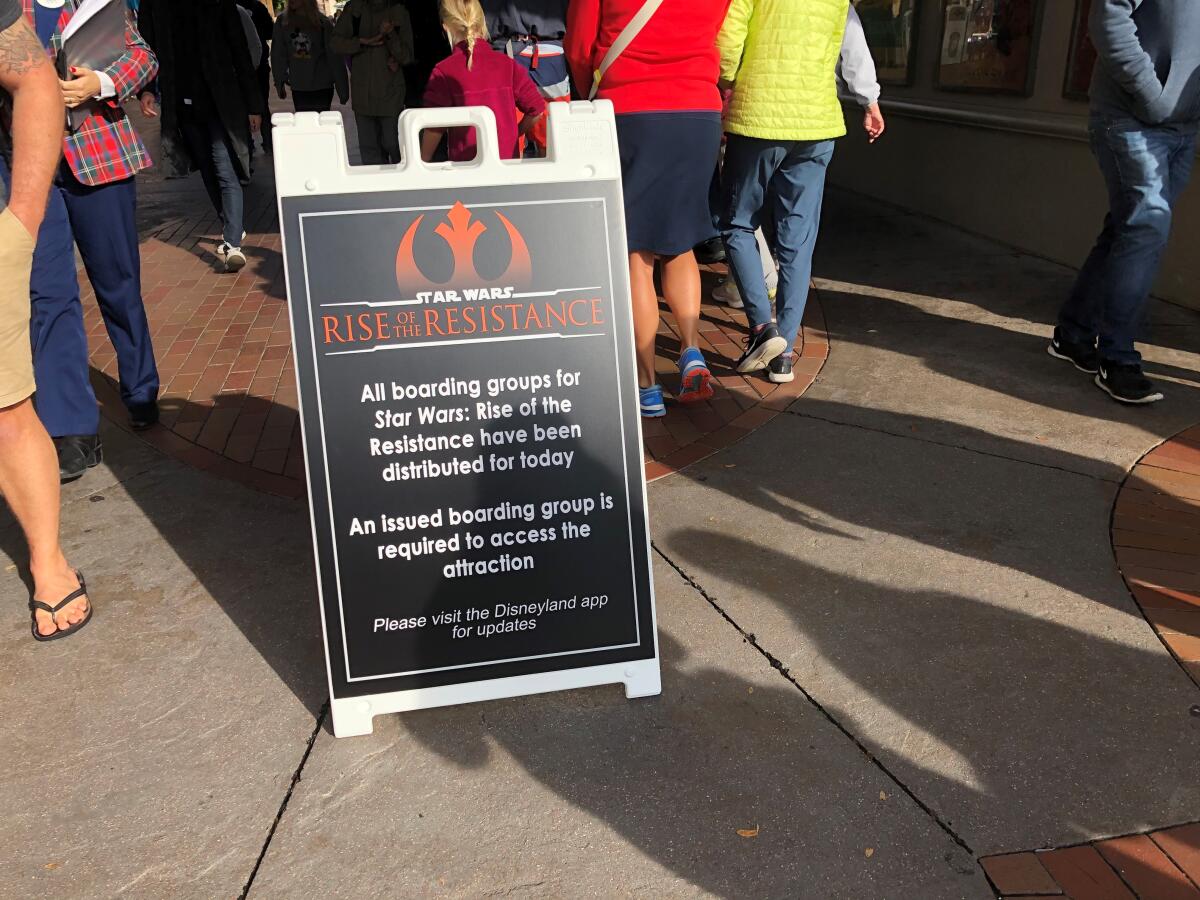Disneyland’s Rise of the Resistance fills up fast. Why you may still score a seat

- Share via
For the last few weeks, Disneyland has opened each day with a hush falling over the early-morning crowd as visitors tap on their smartphones to access a virtual queuing system in hopes of getting on the park’s newest attraction, Rise of the Resistance.
Within minutes after the queuing system begins to accept reservations, the ride reaches capacity for the day. The air fills with cheers from parkgoers who managed to secure a reservation and complaints from those who weren’t so lucky.
But for all the grousing about how hard it is to get on the new attraction, analysis by theme park fans and industry experts suggests that Rise of the Resistance has an above-average daily rider capacity that is on par with other park favorites such as Space Mountain and the Matterhorn Bobsleds.
That capacity is expected to improve as the technical glitches are worked out on the weeks-old attraction.
“As the ride matures and works out the bugs, that percentage of function will become higher and higher,” said Dennis Speigel, president of the Ohio-based consulting firm International Theme Park Services.

Rise of the Resistance opened Jan. 17 at Disneyland, the second of two attractions in the $1-billion Star Wars land that debuted in spring 2019. The attraction was touted as Disneyland’s most technologically advanced ride ever, combining several high-tech features to put visitors in the middle of a battle between resistance fighters and the evil First Order.
Anticipating throngs of visitors, the park requires that visitors who want to ride the attraction use a virtual queuing system that issues “boarding groups” via the Disneyland phone app.
The phone app issues boarding reservations after the park’s scheduled opening time and only to people physically in the park. The lower the boarding group number, the sooner you will be notified via the app when it’s time to get on the ride.
Disneyland representatives have been tight-lipped about how many parkgoers are getting on the ride each day, but curious fans and statisticians have made daily capacity estimates. They either count the number of people who exit the ride per hour or calculate how often the Disneyland app issues new boarding groups, estimated to include about 150 people each.
Touring Plans, a travel planning site that offers crowd data on several major theme parks, came up with an hourly and daily capacity by assigning employees to count passengers exiting the ride for two hours a day for more than two weeks after the ride opened. Other Disney watchers have been able to estimate the hourly capacity rate by tracking the pace that the smartphone app issues new boarding groups.
Sit back and enjoy the ride? No more. From Disney’s new Star Wars: Rise of the Resistance to Japan’s upcoming “living video game” Super Nintendo World, theme-park audiences must participate to get the full experience.
Based on those methods, the attraction is estimated to be serving 1,100 to 1,500 visitors an hour but can increase to 1,900 passengers an hour when the attraction operates without glitches. That means that 17,600 to 30,400 people can ride the attraction on a day when the park operates for 16 hours, according to Touring Plans and other estimates.
That capacity compares favorably with other popular attractions in the park, according to theme park industry experts.
“About 1,800 guests per hour for an immersive ride is in the upper end of the scale,” said Bill Coan, chief executive of Itec Entertainment, a developer of theme park attractions and shows.
Martin Lewison, a theme park expert and assistant business professor at Farmingdale State College in New York, called the estimated capacity good for a new, highly popular attraction that is loaded with high-tech features.
About 1,900 per hour “is what they should be running for a super, major attraction,” he said. “For the greatest, most popular theme park ride in the world, they need high capacity.”
By comparison, the Matterhorn Bobsled ride and Space Mountain at Disneyland each serve about 1,500 visitors an hour, while the Jungle Cruise attraction serves fewer than 1,000 people an hour, according to Touring Plans, which has also counted riders exiting these and a handful of other rides.
Disney representatives declined to comment on ride capacity but said Rise of the Resistance is one of the “most highly rated attractions” in Walt Disney World and Disneyland.
Hourly capacity, also called “through-put rate” or flow, is a crucial measurement in the theme park industry because when queues move too slowly, customers get frustrated and don’t return. Roller coasters have among the highest hourly capacity rates partly because the ride itself typically lasts less than three minutes.
But theme park operators don’t want to operate only high-capacity rides. Theme parks want to offer a variety of rides — including thrill rides such as roller coasters and kiddie rides such as carousels and bumper cars — to attract adults, teens and younger children.
Roller coasters at Six Flags Magic Mountain in Valencia, such as Ninja — a 90-second ride that serves 1,600 riders an hour — and Viper — a 2½-minute ride that serves about 1,700 riders an hour — are popular with thrill-seeking teenagers but are not as popular with families with small children, who tend to spend more on food and souvenirs, industry experts say.

Immersive rides that try to tell a story using animatronics, 3-D effects and other technology usually have a longer duration, which can often reduce the daily capacity. The Rise of the Resistance lasts nearly 20 minutes.
“It’s about serving as many different guests as possible,” Lewison said.
What is the optimum number of park visitors passing through an attraction?
Park operators try to ensure that visitors can, on average, experience at least one attraction every 40 minutes, according to Dennis Speigel, chief executive at International Theme Park Services in Cincinnati. If parkgoers wait longer than 40 minutes, they get frustrated and don’t return. If they wait less than that, they don’t stay in the park long enough to spend on food and souvenirs, he said.
Theme park operators also try to arrange the location of the rides so that popular attractions with long queues are not adjacent to one another, creating congestion and crowding.
“It’s imperative that you distribute the crowds throughout the park,” Coan said.
Rise of the Resistance may offer a relatively high daily capacity because the attraction uses multiple ride vehicles, as many as 15, each carrying eight passengers. Visitors walk or ride a vehicle from one scene to the next, keeping the stream of riders moving nonstop.
Since the ride opened, it has gone offline several times, forcing Disneyland to stop calling new boarding groups and sharply reducing the average hourly capacity.
“The more aggressive you get with leading-edge technology, then you are likely to get hiccups.”
— Bill Coan
Theme park experts predict that the attraction will begin to serve a higher hourly capacity as technical and mechanical glitches are resolved.
“The more aggressive you get with leading-edge technology, then you are likely to get hiccups,” Coan said.
That is of little comfort to the crowds of park visitors who each day fail to get a boarding group reservation and are forced to return to try another day. Even if the ride operates at optimum levels and serves about 30,000 visitors during a 16-hour day, that means that less than half of the typical daily park attendance, about 65,000, will get to experience Rise of the Resistance each day.
Jonathan Green, a Disneyland annual passholder from Valencia, has been able to get on Rise of the Resistance three times since it opened, thanks to a combination of luck and a few hacks he employed, such as shutting down the Wi-Fi service on his phone to instead use more reliable cell service when logging into the Disneyland app.
Still, Green said he feels bad for the scores of Disneyland fans who travel from out of state to ride the attraction only to be denied a boarding pass.
“If people are coming and staying at a Disneyland hotel, they should be the first to get those boarding passes,” he said. “It’s not right for people to spend thousands of dollars on a vacation and not get on.”
More to Read
Inside the business of entertainment
The Wide Shot brings you news, analysis and insights on everything from streaming wars to production — and what it all means for the future.
You may occasionally receive promotional content from the Los Angeles Times.











